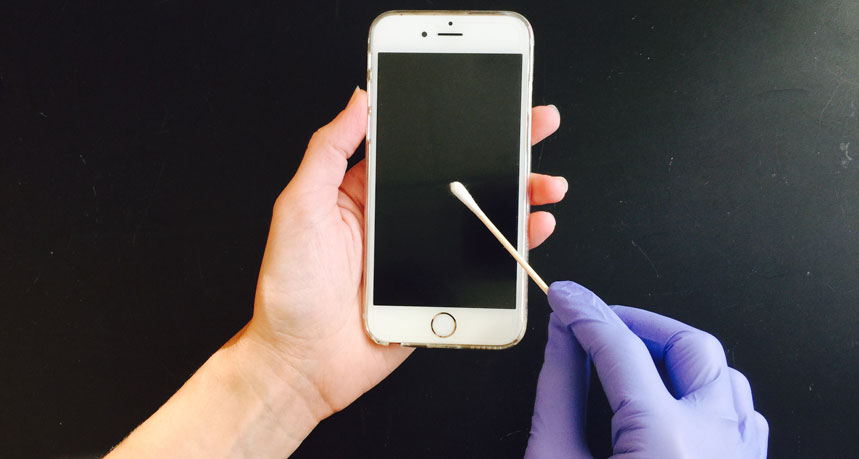Fingers leave tell-tale clues about you on your phone
Chemical residues point to where callers have been and what they had eaten

Chemical traces on a cell phone allow researchers to construct lifestyle sketches of its owner.
Amina Bouslimani and Neha Garg
Every time your fingers touch your cell phone, they leave behind trace amounts of chemicals. And each chemical offers clues to you and your activities. By analyzing them, forensic scientists might be able to piece together a story about your recent life, a new study finds. One day, police might use such data to help track down a phone’s owner. Or they might figure out what a person had recently been up to.
A molecule is a group of atoms. It represents the smallest amount of some chemical. Your skin is covered in molecules picked up by everything you have touched. Those molecules might include traces of the chocolate bar you had snacked on. Or there might be small amounts of shampoo, cosmetics — even some medicine you took. And with each new thing your skin contacts, you leave behind some small share of what it had touched earlier.
Researchers at the University of California, San Diego (UCSD) recently analyzed such chemical leftovers on the phones of 39 volunteers. These residues helped the scientists analyze each phone user’s behavior.
Amina Bouslimani led the study. As a biochemist, she studies the chemical processes that take place inside organisms. Her team’s new tests often could discover if a phone’s owner liked spicy food, drank coffee or used deodorant. The tests could point to places someone had visited recently. They could even point to whether he or she was ill.
Bouslimani’s team published its findings online November 14 in the Proceedings of the National Academy of Sciences.
“Like your skin, your phone also reflects who you are and what you do,” she says. That’s because the average person spends about five hours a day handling their cell phone, she notes.
Jack Gilbert is a microbial ecologist at the University of Chicago in Illinois. He studies how microbes relate to each other and their surroundings. The UCSD research is exciting, he says. That’s because it allows scientists to reconstruct details of a phone owner’s lifestyle.
Consider someone who has just lunched on a peanut butter and jelly sandwich. “A small amount of the jelly, the bread, the butter and even the peanut would be left on your hands,” he says. (Some people’s PB and J sandwiches also contain butter.) That would be true “even after you have washed them,” he notes. In fact, washing would add traces of soap.
Residues from each recent activity would increase the complexity of the mix of molecules left behind.
What the scientists did
To probe those residues, the UCSD team wiped the surface of each volunteer’s phone with a cotton swab. The scientists also swabbed each person’s right hand. Then the researchers compared the chemicals found on each.
If the chemicals matched, it would suggest that those molecules from the skin had been transferred to a user’s phone, says co-author Pieter Dorrestein. He’s a UCSD pharmaceutical chemist. (That means he studies the composition, structure and properties of different types of medicines.)
The scientists identified as many of the molecules as they could. They then compared these to a database of chemicals. Dorrestein had helped set up that database a few years earlier. It contains the profiles of various compounds, including spices, caffeine and medicines.
Traces of anywhere from hundreds to thousands of different molecules turned up on each phone. The molecules reflected what had been in the body, such as medications and food. They also reflected what each person had handled before touching the phone, such as soap or makeup. Indeed, the majority of molecules came from beauty products, medicines and food.
From all of this, Bouslimani says, “We could tell if a person is likely female, uses high-end cosmetics, dyes her hair, drinks coffee, prefers beer over wine or likes spicy food.” These residues might also show whether someone wears sunscreen or bug spray. If so, that could point to someone who spends a lot of time outdoors.
Police already use molecular analyses to look for traces of explosives or illegal drugs. To date, Dorrestein says, he’s never heard of police using phone residues to narrow down behavioral clues to search for a suspect. But detectives might one day use such data to track down someone who left a phone behind at a crime scene.







